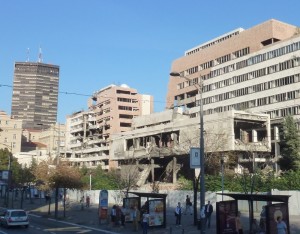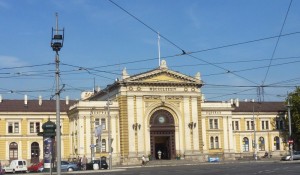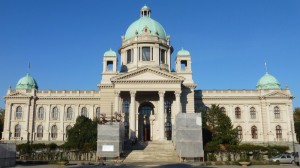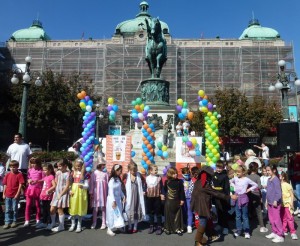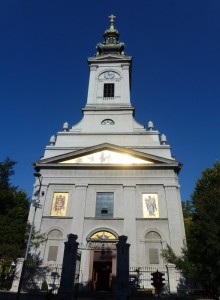I first learnt about Yugoslavia, Tito and political turmoil in the Balkan Peninsula when studying world history in 1970s. Yugoslavia disintegrated following wars and bloodshed in 1990s. After having visited Croatia, Montenegro and Slovenia more than five years ago, I have longed to see other parts of the former Yugoslavia namely Serbia, Bosnia and Herzegovina, Macedonia and Kosovo.
Background
The history of Serbia, as a country, begins with the Slavic settlements in the Balkans, established in the 6th century in territories governed by the Byzantine Empire. The Serbian realm evolved into a Kingdom under Stefan II in 1217 and an Empire in 1345 under Stephen Dusan (1308-1355) before being annexed by the Ottomans in 1540.
The Balkan Peninsula is one of the most complicated regions in terms of history, culture, religion and ethnicity. Serbia a key player in the Balkans has been at war intermittently for the last two centuries. The Serbian Revolution began in 1804 leading gradually to the country’s liberation. Serbia had its first constitution in 1835. In 1876, Serbia finally declared war on the Ottoman Empire proclaiming its unification with Bosnia. The formal independence of Serbia was internationally recognized at the Congress of Berlin in 1878. This treaty however prohibited Serbia from uniting with Bosnia and placed it under the Austro-Hungarian occupation.
Struggle for independence continued. On June 28, 1914, Austrian Crown Prince Franz Ferdinand and wife were assassinated in Sarajevo by Gavrilo Princip, a member of Young Bosnia. This incident served as a pretext for the Austrian declaration of war on Serbia one month later, marking the beginning of World War I (WWI).
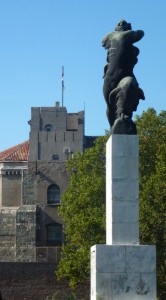 In 1918, Yugoslavia was established as a confederation of South Slavic nations (the union of the State of Slovenes, Croats and Serbs and the Kingdom of Serbia and the Kingdom of Montenegro). Belgrade was the federal capital. In 1941, it was invaded by the Axis powers and was officially abolished in 1943 upon the proclamation of the Democratic Federal Yugoslavia by the Partisans Resistance Movement during WWII. It was renamed as the Federal People’s Republic of Yugoslavia in 1946.
In 1918, Yugoslavia was established as a confederation of South Slavic nations (the union of the State of Slovenes, Croats and Serbs and the Kingdom of Serbia and the Kingdom of Montenegro). Belgrade was the federal capital. In 1941, it was invaded by the Axis powers and was officially abolished in 1943 upon the proclamation of the Democratic Federal Yugoslavia by the Partisans Resistance Movement during WWII. It was renamed as the Federal People’s Republic of Yugoslavia in 1946.
After WWII, Josip Broz Tito (1892 -1980) became the first president of the new Socialist Yugoslavia, a federal state comprising six Socialist Republics namely Slovenia, Croatia, Bosnia and Herzegovina, Serbia, Montenegro and Macedonia and two autonomous regions within Serbia – Vojvodina and Kosovo. In the beginning of Tito’s rule (1945 to 1980), he copied the Soviet model. After the split with the Soviet Union in 1948, Yugoslavia created its own brand of socialism with a hint of a market economy enjoying significant financial loans from both the East and the West. Ivan Stambolic (1936-2000) succeeded Tito and was President of Serbia till December 1987 when he was voted off the position. He disappeared mysteriously in August 2000 and the police later revealed that he was murdered in Fruska Gora by officers of the Special Operations Unit. During trial of the murderers, the court found that the order for the murder came from Milošević. Petar Gracanin was President briefly and was succeeded by Slobodan Milošević (1941-2006) in 1989.
Dissolution of Yugoslavia
Milošević‘s presidency from 1989 to 2000 was marked by the break-up of Yugoslavia and the subsequent Yugoslav Wars in 1990s fueled by ethnic tensions.
Slovenia and Croatia declared independence on June 25, 1991. This move was objected to by the ethnic Serb population. The Yugoslav People’s Army (JNA) tried to prevent secession of Slovenia in the Ten Day War (June 26-July 7, 1991) and of Croatia in the first phase of the Croatian War of Independence from June 27, 1991 to the truce on January 1992.
Macedonia left the federation peacefully on September 25, 1991.
Bosnia and Herzegovina declared independence on March 5, 1992 leading to the Bosnia War between March 1, 1992 and December 1995.
War broke out in Kosovo when the Yugoslav government forces fought with the Albanian separatist forces from 1998 to 1999. NATO countries intervened and the bombing of Yugoslavia lasted from March 24 to June 10, 1999 leading to the withdrawal of Yugoslav forces from Kosovo and the establishment of UN mission in Kosovo. This put an end to the Yugoslav Wars of 1990s.
In the midst of the 1999 NATO bombing of Yugoslavia, Milošević was charged with war crimes and crimes against humanity in connection with the wars in Bosnia, Croatia and Kosovo by the International Criminal Tribunal for the former Yugoslavia (ICTY).He was found dead in his cell in The Hague in March 2006.The fall of Milošević in 2000 ended Yugoslavia’s international isolation. He was sent to the ICTY.
In 2003, the Federal Republic of Yugoslavia was renamed Serbia and Montenegro. In May 2006, Montenegro held a referendum and 55.4% of the voters were in favour of independence. One month later, the National Assembly of Serbia declared Serbia to the legal successor to the former state union.
On February 17, 2008, the Kosovo parliament unilaterally proclaimed independence from Serbia. International reactions have been divided: the US, UK, Germany, France and a dozen other countries have recognized Kosovo’s independence while Serbia, Russia, China, India, Brazil and other countries consider it illegal. In July 2010, the United Nations International Court of Justice deemed the separation of Kosovo legal. Relationship between Serbia and Kosovo remains tense.
Serbia has a population of about 7 million (excluding Kosovo). Serbs are the largest ethnic group (82%). As for religion, about 85% and 5% of the population follow the Orthodox Church and Catholic Church respectively. It officially applied for the European Union membership in December 2009 and became an official candidate in March 2012.
October 3 (Wednesday): Sophia, Bulgaria (GMT+2) – Belgrade, Serbia (GMT+1) (330km)
The journey from Sofia, Bulgaria to Belgrade, Serbia was very smooth. Once we were on Serbian soil, the bus stopped for lunch. I changed my Bulgarian leva into Serbian dinar (DIN) (1euro to 113/115DIN). During the lunch break, I had a conversation with Rani and Nilly from Israel. They had booked a hotel while I had to look for one on arrival.
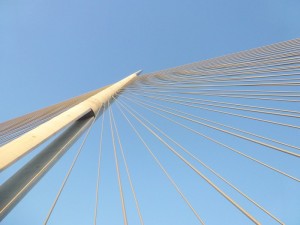 We thought the bus would be going to the town centre. To our surprise, the driver told us to get off in Novi (New) Belgrade. We had to take a taxi to the hotel. I found a 2-star hotel at Trg Slavija near their hotel. Hotel Slavija must have been built during the communist era: it has the soviet look with dim light, grey marble floor, and uninviting lobby with only three sofas. The room which cost 30euro is very basic and old. By comparison, I find B&B and hostels cozier and more welcoming.
We thought the bus would be going to the town centre. To our surprise, the driver told us to get off in Novi (New) Belgrade. We had to take a taxi to the hotel. I found a 2-star hotel at Trg Slavija near their hotel. Hotel Slavija must have been built during the communist era: it has the soviet look with dim light, grey marble floor, and uninviting lobby with only three sofas. The room which cost 30euro is very basic and old. By comparison, I find B&B and hostels cozier and more welcoming.
In the evening, Rani, Nilly and I walked along the main street Kralija Milana to the old town. We had a great dinner at Ima Dana in Skadarska in Stari Grad, the oldest part of the capital. The waiter recommended us to share a meat dish. The grilled meat was tender and delicious and we had some local wine. I had a wonderful time chatting about everything under the sun!
Rani and Nilly saw leaflets on a pub crawl starting at 9pm. They checked the internet and called the number. But the phone line was disengaged. Nilly thought the tour might not be running. But we were all persistent old folks in search of truth. We went to the meeting point and waited for 15 minutes. No one turned up. Nilly was right: the pub crawl was over. The organizer should have put the latest information in their website or left a message on the phone instead of wasting our time! They walked me back to my hotel. I had a good night sleep.
October 4: Belgrade
Belgrade is strategically located on the southern edge of the Carpathian Basin where the Sava River meets the Danube. It has been built, destroyed and rebuilt over 40 times in its 2300-year history.The first thing I had to do was to buy a ticket to Sarajevo. According to information provided by the hotel receptionist, there was only one bus leaving at 7am. I decided to make a trip to the train and bus stations to get the latest information.
The train station by the Sava River is impressive. While I was queuing up, I met a couple who had just arrived from Sarajevo on a minibus operated by GEA. While the minibus takes about five hours, the train leaving at 8am would take nine hours. The bus would leave at 4pm and arrive around 11pm.
I walked to GEA whose staff was most helpful. They suggested I break up the journey, spend a night in Drvengrad, an ethno village and take the ‘Nostalgija’ train called ‘Sargan eight’. GEA minibus would take me up the following day. They booked a hotel for me (4230DIN for half board). It was a bit pricy but I was happy to see the Serbian mountain region (I later found out that the hotel next to the ‘Sargan eight’ train station would only cost 2600DIN).
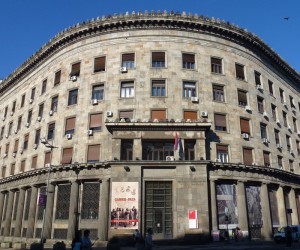 |
Having fixed my travel plan to Bosnia, I spent the next seven hours sightseeing. I walked along Kralija Milana for the third time and arrived at the Republic Square, the focal point in Stari Grad with a statute of Prince Michael who expelled the Turks in 1867. As I was not in the mood to spend hours in a museum, I gave the National Museum a miss. I stopped at the Tourism Office which told me about an open-air bus tour leaving at 4pm.
The only museum I visited in Belgrade was the Ethnographical Museum. The collection of costumes from different regions and folk arts is good with useful illustrations in English. While the exhibits are good, the building itself, the presentation and lighting are dull. There is also a special exhibition on urban embroidery which aims to shed lights on the presence of European tradition in Serbian culture and on the pursuit of national heritage and its revival.
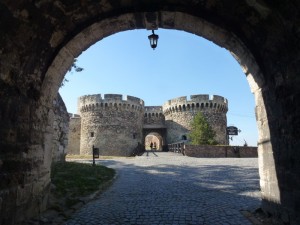 |
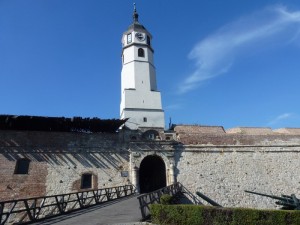 |
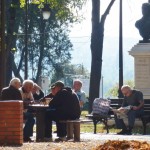 |
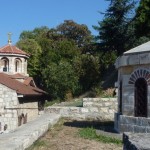 |
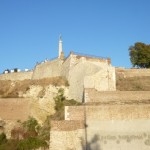 |
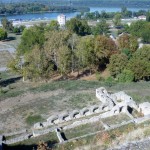 |
My next stop was the massive Kalemegdan Citadel at the northwest end of the peninsula where the Sava River joins the Danube. The fortress dates back to the Celtic times and the citadel in its present form dates from the 17th century. There is a Military Museum but I had no time to visit. I saw a sculpture with an inscription ‘A La France’ which is an expression of appreciation for the assistance given by France during the WWI.
I strolled in the park reaching the four corners of the fortress and visiting the St Petka and Ruzica Churches which face the Danube and the Statute of the Victor which overlooks River Sava.
My final stop of my walking tour was St Michael’s Cathedral which has a magnificent interior in baroque style. It was very hot and I had an ice-cream in lieu of lunch: a habit I had acquired since my Central Asia trip. I proceeded to the meeting point for the bus tour at the park opposite the National Assembly. I suddenly heard a familiar voice calling me: it was Nilly. I was delighted to see them again.
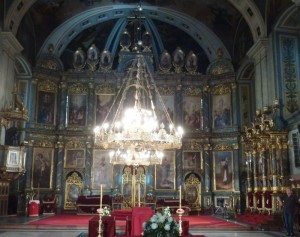 |
The bus was 20 minutes late and did not set off till 4:30pm. The operator should run the service on time. It only cost about 5euro. We had a headset but the sound system was poor. Better and more interesting explanations could have made the trip more informative. The trip was too long and did not finish till 6:30pm. A lot of time was spent in Novi (new) Belgrade which is not really interesting. The commentator even mentioned the Hyatt Hotel as the first American investment in the area and the importance of the congress centre. If there is not much worth seeing, I prefer a shorter trip.
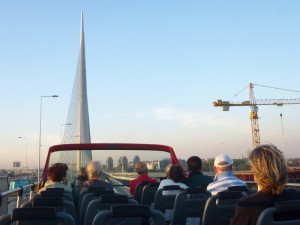 |
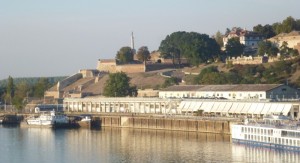 |
On my way back to the hotel, I went to see St Sava Church, the world’s largest Orthodox Church. The outside is fairly impressive especially in floodlight. But the interior with bare concrete walls is under repair.
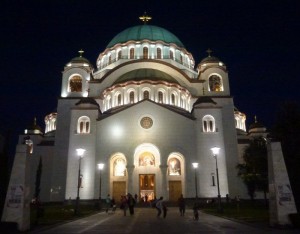 |
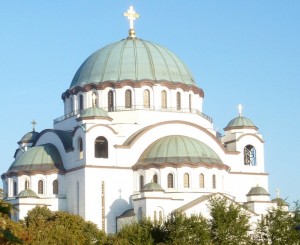 |
Rani and Nellie gave me a treat and took me to the best seafood restaurant in Zeeman along the Danube. Nellie ordered a huge sea bass for three of us and Rani chose a nice bottle of white wine. We had a wonderful evening and arranged to meet up for another dinner in Sarajevo as we would arrive on the same date.
October 5- Belgrade –Drvengrad (200km)
My minibus picked me up at 7am. Sinis the driver is courteous and well-dressed. I had my second tour of Belgrade as he drove around to pick up four more passengers.
We drove south to ČaČak and then turned west. The road is fairly good and the scenery especially from Užice to Mokra Gora is pretty with mountain ranges, alpine trees, rivers and farms.
I paid 20euro and disembarked at Drvengrad (meaning wooden town) which was created by the famous Serbian director Emir Kosturica for the movie ‘Life is a Miracle’. The wooden houses here are unique.
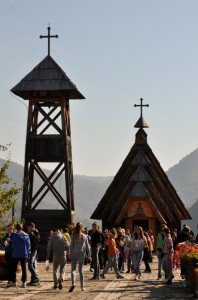 |
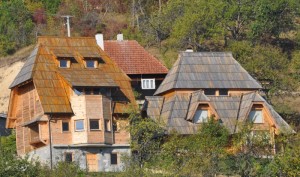 |
A pretty young receptionist told me that the 4:30pm ‘Sargan 8’ train was full and I could only take the 10:30am train the following day. As my bus would pick up me the following day around noon, it would upset my travel plan if I took the 10:30am train. In any case, I asked her to make a reservation for me.
I never give up easily. I was lucky to meet two guests who happened to have taken the afternoon train the day before. The receptionist had told them the same thing. But they went to the station and got a ticket without problem.
I took their advice and walked 1.5km to the station. The train actually left at 4:20pm (and not 4:30pm). The ticket office told me that they did not take reservation and had not received any call from the hotel receptionist. A service provider should provide accurate information to customers. But in this case, I am sad to say that the hotel receptionist has failed in her duty.
I purchased a ticket for 600DIN and stood during the entire journey. The train was filled with school children who showed great interest in my strange face. I had a good time taking pictures for them!
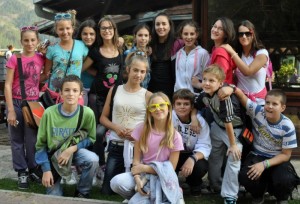 |
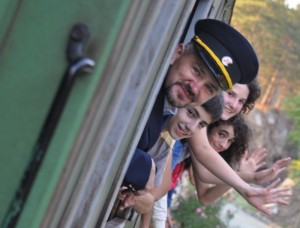 |
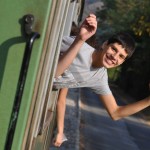 |
The 13.5-km long railway constructed between 1921 and 1925 is running on a narrow-gauge track through the Sargan Mountain area. It makes an unusual path in the shape of number eight (8) in order to solve the altitude difference of 300m at the length of 3.5km between the railway station of Sargan-Vitasi and Mokra Gora. It goes down the canyon of River Kamesina to the gentle valley of Mokra Gora. The train passes through five bridges and 22 tunnels the longest of which is 1.6km long. We had three stops at Jatare, Sargan-Vitasi and a viewing-platform to admire the landscape and the construction of this unique railway. The kids first screamed like mad when we passed through the first dozen of tunnels (This reminds me of Munch’s world famous painting ‘Scream’). Their scream died down later possibly through fatigue and loss of novelty!
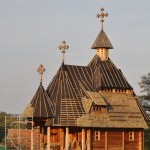 |
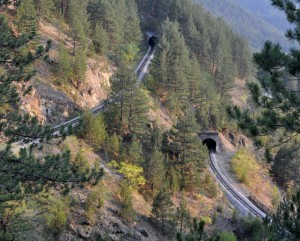 |
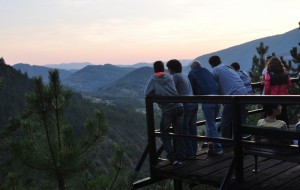 |
The journey lasted over two hours. I took a short-cut (the hotel receptionist could have advised me to take this route) and got back to my room at 7pm. The buffet dinner was served in a lovely and cozy dining hall. The security guard came up and told me that my bus would pick me up at noon. I was in a writing mood and did not go to bed till 2am in the morning.
October 6 (Saturday): Drvengrad, Serbia – Sarajevo, Bosnia and Herzegovina (100km)
I had a late breakfast and was reading news on internet. Suddenly, the young receptionist rushed in telling me that my bus had arrived. It was only 11am. I treasure punctuality and was embarrassed as other passengers had to wait for me. I packed and was aboard the bus ten minutes later. I think there must have been a communication problem: the GEA staff might have said the pick-up time was between 11am and noon. The hotel staff had only picked up the reference to ‘noon’. Anyway, it was not my fault!
I paid another 20euro for the trip to Sarajevo. The route through the Sargan Mountain region is scenic. We reached the border within 20 minutes. There were few vehicles at the checkpoint and the bus was in Bosnia before 12noon.
Remarks
When I was at high school, there was only a Federal Republic of Yugoslavia which was communist and its leader was Tito. From 1980s onwards, the republic was embroiled in ethnic and religious conflicts leading subsequently to wars, ethnic cleansing and genocides. The war scars are still evident as one travels through the Balkan Peninsula today. In Belgrade, several buildings including the Ministry of Defense which had been bombed in 1999 are still standing.
Belgrade as a capital looks prosperous and stately with many historical and magnificent buildings. The national highway network is fairly good. On my way to Bosnia, I also found the rural side thriving and pretty with large and well-maintained houses and farms. It is however difficult to tell whether the general Serbian population has a decent living.
I enjoy my time in Mokra Gora. The mountains are beautiful. I had lots of fun with the kids during the train ride. I am glad they are eager to speak English and get to know Hong Kong / China.
I regret I remain ignorant about the real Serbia after my trip. I did not have a chance to interact with the Serbs to find out how they feel about the Yugoslav Wars and Serbia’s relationship with its neighbours especially Kosovo. I also have not seen any of Serbia’s four World Heritage properties. I hope to revisit and better understand this country one day.
“.


